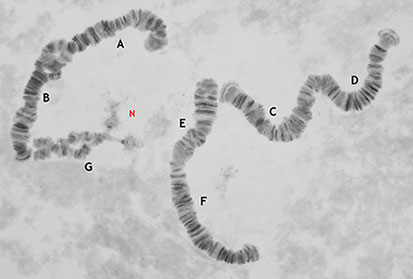Species 4l. C. decorus-group? species 4l.Known from three larval specimens with polytene chromosomes. Adult and Pupa not known. Fourth instar larva: A medium sized melanotus-type larva (length (2) 12.7-13.5 mm), ventral tubules well developed and about equal in length (ant. 1.24-1.56; post 1.28-1.52.); lateral tubules about 156-160 µm. Anal tubules 2-4 times as long as wide probably because the dorsal pair are longer (abt. 470 µm) while the ventral pair are shorter (abt. 320 µm). Gular region dark over posterior 1/2 to 2/3, wider than the mentum and with the widest point anterior to the posterior margin of the head capsule, frontoclypeus pale. Oesophageal opening about 68-81 µm wide and 3.9-4 times wider than deep.
Mentum (Fig. a) with 4th laterals reduced to about level of 5th lateral (type II); c1 tooth narrow and tall, c2 teeth separated (type IB or III).
Ventromentum (Fig. b) about 202-210 µm wide, 3.15-3.61 times wider than deep; 1.07-1.23 times the mentum width; with about 31-34 striae; VMR about 0.25 (0,24-0.26). Pecten epipharyngis (Fig. c) with about 14-16 mostly even sized, sharp teeth, but distal teeth smaller.
Premandible with inner tooth slightly longer and about 3.3-4 times the width of the outer tooth, both teeth narrowing markedly to a sharp tip.
Antenna with basal segment relatively long and narrow, 0.4 of ventral head length, about 3.3-4.3 times as long as wide; RO about 30-40% up from base; AR about 2.24-2.53; A2/A1 about 0.19-0.22; A4/A3 about 1.5-2.4; segment lengths (micron) about 105 : 22.5 : 8 : 10 : 6.
Distance between the antennal bases probably about the same as that between the S4 setae, which are separated by about 77-86% of the frontoclypeus width.
Mandible (Fig. d) about 240-250 µm long, with 3rd inner tooth pale and almost completely fused (type IA); 18-19 furrows on the outer surface near the base; 10-11 taeniae in the Pecten mandibularis; Mdt-Mat about 30 µm and MTR 0.33-0.36. Cytology: 4 polytene chromosomes with thummi-cytocomplex arm combination, AB, CD, EF, G.
Arm G often largely unpaired and with a virtually terminal nucleolus and a BR separated by a further 7-10 bands. Polymorphism at least in arm B near the centromere and arm E. Bulb (seg7) subterminal in arm B with some dark bands immediately proximal.  Found: Kansas - Mill Creek (38.95°N, 94.80°W), nr. Craig, Kansas.
Louisiana - Bar ditch, Many, Sabine Parish. See also C. decorus, C. bifurcatus, C. sp. b, C. sp. c, C. sp. j, C. sp. 2a, C. &39;proulxi', C. 'butleri', C. sp. 3h, C. sp. 3i, C. sp. 3j, C. sp. 3r, C. harpi, C. blaylocki, C. mozleyi, C. winnelli.| Return to Index| Go to References ] |
